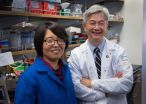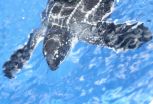(Press-News.org) UCLA research could lead to a simple saliva test capable of diagnosing — at an early stage — diabetes and cancer, and perhaps neurological disorders and autoimmune diseases.
The study, the most comprehensive analysis ever conducted of RNA molecules in human saliva, reveals that saliva contains many of the same disease-revealing molecules that are contained in blood. It was published online today by the peer-reviewed journal Clinical Chemistry and will be published in the journal's January 2015 special print issue, "Molecular Diagnostics: A Revolution in Progress."
"If we can define the boundaries of molecular targets in saliva, then we can ask what the constituents in saliva are that can mark someone who has pre-diabetes or the early stages of oral cancer or pancreatic cancer — and we can utilize this knowledge for personalized medicine," said Dr. David Wong, a senior author of the research and UCLA's Felix and Mildred Yip Endowed Professor in Dentistry.
Wong said the test also holds promise for diagnosing Type 2 diabetes, gastric cancer and other diseases. "If you don't look in saliva, you may miss important indicators of disease," Wong said. "There seems to be treasure in saliva, which will surprise people."
RNA, widely known as a cellular messenger that makes proteins and carries out DNA's instructions to other parts of the cell, is now understood to perform sophisticated chemical reactions and is believed to perform an extraordinary number of other functions, at least some of which are unknown.
Wong's research over the past decade has focused on identifying biomarkers in saliva. His laboratory discovered that some of the same RNA that is inside human cells are also present in saliva and can be used to detect diseases — a surprising finding, he said, because enzymes in saliva can degrade RNA, making the mouth "a hostile environment."
The new research is a collaboration with Xinshu (Grace) Xiao, the paper's other senior author and a UCLA associate professor of integrative biology and physiology. Using state-of-the-science genomics and bioinformatics, the researchers analyzed 165 million genetic sequences.
Among the many forms of RNA are some unusual ones that live in the mouth and in cells. For example, it wasn't known until very recently that RNA comes in a circular form; the linear form has long been known. But the UCLA scientists identified more than 400 circular RNAs in human saliva — the first discovery of circular RNA in saliva or any body fluid — including 327 forms that were previously unknown.
Circular RNA's function in saliva is not entirely understood, although it does serve as a sponge for tiny RNA molecules called microRNAs, which bind to it.
"Circular RNAs in saliva may be protecting other RNAs," said Xiao, who also is a faculty member in the UCLA College and a member of UCLA's Molecular Biology Institute. It's likely, she said, that circular RNAs in saliva protect microRNAs from being degraded.
MicroRNAs, which once seemed to be little more than molecular noise, play important roles in many cell types, and have been implicated in cancers and other diseases, Xiao said. One microRNA can regulate hundreds of genes, she said.
The scientists compared microRNA levels in saliva to those in the blood and other body fluids, and found the levels of microRNA in blood and in saliva are very similar — indicating that a saliva sample would be a good measure of microRNAs in the body.
They also found that saliva contains another class of small RNAs, called piwi-interacting RNAs, or piRNAs, which are produced by stem cells, skin cells and germ cells. There are very few piRNAs in blood and most other body fluids, but Xiao's analysis showed that piRNA are abundant in saliva. Although their function is not yet known, Xiao said they may protect the body from viral infection.
While most RNA molecules translate genetic code from DNA to make proteins, there is also a class called non-coding RNAs that does not.
"Saliva carries with it non-coding RNAs, microRNAs, piRNAs and circRNAs that are biomarkers for disease and health monitoring," said Wong, who also is associate dean of research at the UCLA School of Dentistry. "Had we not done this collaboration, we would never know that non-coding RNAs, microRNAs, piRNAs and circRNAs exist in saliva."
Their overriding conclusion is that saliva has tremendous medical and scientific value. In the not-too-distant future, dentists might be able to take saliva samples to analyze for a variety of diseases. And, Wong says, the research could lead to a new category of self-diagnostic devices. "This could indicate that wearable gear that informs you whether you have a disease — even before you have any symptoms — is almost here," he said.
The scientists, both members of UCLA's Jonsson Comprehensive Cancer Center, will continue their research, aiming to better understand the biology behind their findings, including the function of piRNAs.
"With a collaborator like Dr. Xiao, UCLA will continue to spearhead this science," Wong said. "Now we have the capability and technology to reach deeper and study non-coding RNA, which has never been done."
INFORMATION:
Co-authors of the research were UCLA postdoctoral scholars Jae Hoon Bahn and Qing Zhang in Xiao's laboratory; Feng Li, an assistant researcher in Wong's laboratory; Tak-Ming Chan, a former postdoctoral scholar in Xiao's laboratory; Xianzhi Lin, a postdoctoral scholar in Xiao's laboratory; and Yong Kim, a UCLA adjunct associate professor of dentistry.
The research was supported by the NIH's National Center for Advancing Translational Sciences (award UH2TR000923) through the Extracellular RNA Communication program.
MADISON, Wis. — Bigger is better, if you're a leatherback sea turtle.
For the first time, researchers at the University of Wisconsin-Madison, Florida Atlantic University (FAU), and the National Oceanic and Atmospheric Administration (NOAA) have measured the forces that act on a swimming animal and the energy the animal must expend to move through the water.
A surprising finding: Longer, slender turtles are less efficient swimmers than more rotund turtles, which get better stroke for their buck.
By taking these measurements, the research team — led by UW-Madison's ...
Heparin, the life saving blood thinner used in major surgeries and treatment of heart diseases, is a complicated drug but a research team from the University of British Columbia has set out to make its use a lot safer by developing a universal antidote.
Heparin's blood thinning action often requires an antidote to reverse its effect before serious bleeding issues arise especially in the case of major surgical procedures.
Finding an approved drug to reverse the blood thinning effect of heparin is complicated because there are about a dozen approved heparin products ...
Maggot infestations, rotting carcasses, unidentifiable gunk in the kitchen sink – how much your brain responds to disgusting images could predict whether you are liberal or conservative.
In a study to be published in an upcoming issue of Current Biology, an international team of scientists led by Virginia Tech reports that the strength of a person's reaction to repulsive images can forecast their political ideology.
"Disgusting images generate neural responses that are highly predictive of political orientation even when those neural responses don't correspond ...
Sleep apnea may affect your ability to form new spatial memories, such as remembering where you parked your car, new research led by NYU Langone Medical Center sleep specialists suggests.
The study, published online Oct. 29 in Journal of Neuroscience, demonstrates through the playing of a specific video game that disruption of rapid eye movement (REM) sleep as a consequence of sleep apnea impairs spatial memory in humans even when other sleep stages are intact.
Spatial memory is utilized for everyday tasks, such as remembering the location of a favorite restaurant, ...
Wind shear has kicked in and has been pushing clouds and showers away from Tropical Cyclone Nilofar's center. NASA's Aqua satellite captured an image that showed the effects of the shear on Oct. 29.
The Moderate Resolution Imaging Spectroradiometer aboard NASA's Aqua satellite captured an image of Tropical Cyclone Nilofar on Oct. 29 at 09:00 UTC (5 a.m. EDT). Tropical Cyclone Nilofar is moving through the Arabian Sea. The image shows that clouds were being pushed to the northeast of the center of the storm, from strong southwesterly wind shear.
On Oct. 29 at 1500 UTC ...
In the largest study of its kind to date, researchers have used DNA sequencing to uncover dozens of genes that heighten the risk for autism. Joseph Buxbaum, Ph.D., Icahn School of Medicine at Mount Sinai, New York City, Mark Daly, Ph.D., Broad Institute of Harvard and MIT, and their colleagues examined more than 14,000 DNA samples from affected children, parents and unrelated people. They identified changes in 107 genes that are likely to contribute to the risk for autism spectrum disorder (ASD) – a jump from the nine genes implicated in earlier studies using these ...
Small differences in as many as a thousand genes contribute to risk for autism, according to a study led by Mount Sinai researchers and the Autism Sequencing Consortium (ASC), and published today in the journal Nature.
The new study examined data on several types of rare, genetic differences in more than 14,000 DNA samples from parents, affected children, and unrelated individuals – by far the largest number to date – to dramatically expand the list of genes identified with autism spectrum disorder (ASD).
Most of the genes that contribute to autism remain ...
A research group led by Anne Dutrey from the Laboratory of Astrophysics of Bordeaux, France, and the National Centre for Scientific Research (CNRS) observed the distribution of dust and gas in a binary star system called GG Tau-A. It was recently discovered that one of GG Tau-A's components is itself a double star. This object is only a few million years old and lies approximately 460 light-years from Earth in the constellation Taurus.
Like a wheel in a wheel, GG Tau-A contains a large, outer disk encircling the entire system as well as an inner disk around the main central ...
Mouse lemurs can live at least eight years in the wild – twice as long as some previous estimates, a long-term longitudinal study finds.
PLOS ONE published the research on brown mouse lemurs (Microcebus rufus) led in Madagascar by biologist Sarah Zohdy, a post-doctoral fellow in Emory University's Department of Environmental Sciences and the Rollins School of Public Health. Zohdy conducted the research while she was a doctoral student at the University of Helsinki.
"It's surprising that these tiny, mouse-sized primates, living in a jungle full of predators that ...
A team led by the Lawrence Livermore scientists has created a new kind of ion channel based on short carbon nanotubes, which can be inserted into synthetic bilayers and live cell membranes to form tiny pores that transport water, protons, small ions and DNA.
These carbon nanotube "porins" have significant implications for future health care and bioengineering applications. Nanotube porins eventually could be used to deliver drugs to the body, serve as a foundation of novel biosensors and DNA sequencing applications, and be used as components of synthetic cells.
Researchers ...




